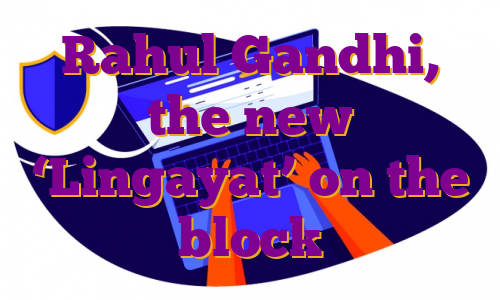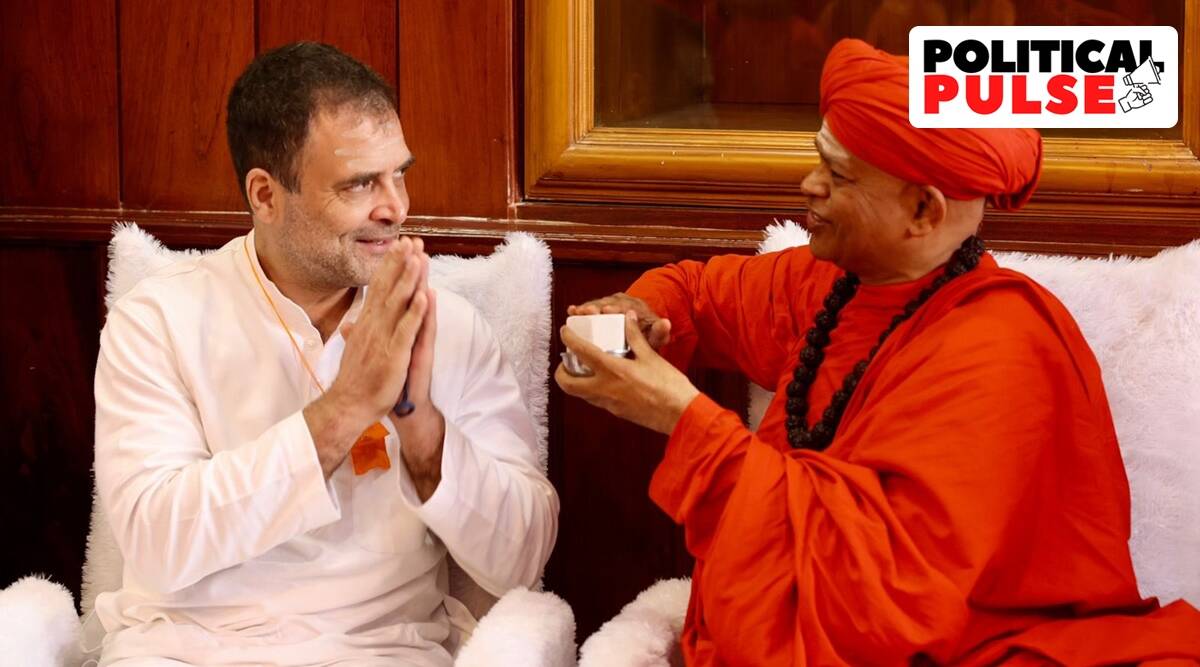RAHUL Gandhi was a man on a mission on his two-day tour to Karnataka starting Tuesday. If one of his aims was to settle the tremors within the Congress over a grand Siddaramaiah birthday that left rivals – particularly D K Shivakumar – jittery, another crucial move was an outreach to the influential Lingayat community. On a visit to the Murgha Mutt, a prominent ashram in the Chitradurga region, Wednesday, Rahul took “initiation” into the Lingayat sect, which is considered a separate religion by its followers.
As part of the initiation, the senior Congress leader was given Ishtalinga, a symbol of ‘the universal force’, to wear. Tied to a thread that lies across the chest or body, Ishtalinga is usually put on children born in Lingayat families at the time of their naming ceremony, but can be tied at any time by persons who accept the Lingayat philosophy that revolves around a universal force, equality and secular values, say experts.
Following the ceremony, Rahul said: “It is an absolute honour to visit Sri Jagadguru Murugharajendra Vidyapeetha and receive the Ishtalinga deeksha from Dr Sri Shivamurthy Murugha Sharanaru.”
A website on the Lingayat sect calls the tying of the Ishtalinga “the main and important ritual for a Lingayat”. “Any human being irrespective of rich or poor, male or female, officer or clerk, director or office boy, black or white, can become a Lingayat by Ishtalinga deeksha.”
As per the website Lingayatreligion.com, the Lingayats are strict monotheists and enjoin the worship of only one God, namely, Linga (Shiva). The word ‘Linga’ here signifies “universal consciousness” qualified by “universal energy (shakti)”. Though Lingayats often refer to Shiva or Parashiva, for them he is not the mythological Shiva, but a formless God.
The practice of wearing the Ishtalinga was started by the 12th-century saint Basavanna, the founder of the Lingayat faith, as a rebellion against discrimination of women in the Upanayana or thread ceremony of Brahmins.
“We believe a member of any community can be a religious guru. Once a person becomes a part of the Lingayat faith, he can become a world guru of the community. Women have equal status as men among the Lingayats and they can be world gurus,” says Lingayat seer Dr Basavalinga Pattadevaru of the Hiremath Samsthana Bhalki ashram, which was established over five decades ago.
“While caste discrimination is central to the post-Manu Hinduism, Basavanna… and his associates… asked their followers not to observe it. They held that that once a man undergoes the initiation wherein he is given an Ishtalinga, he becomes superior and, therefore, all Lingayats must be treated as equal,” says a paper on Lingayatism authored by former chairman of the Department of Philosophy at Karnatak University Prof N G Mahadevappa.
While as per a Lingayat religion website, a follower is advised to do Ishtalinga puja daily, preferably early morning between 3 am and 5 am, there are no strict rules.
Dr Basavaraj Ballur, a scholar on the teachings of Basavanna, says that the significance of the Ishtalinga deeksha is not as much as it used to be. “Now anyone who wants it, can take it. For example when the Sharana (socio-religious) movement started, many people who were not born Lingayats, tied the linga. However merely tying the linga does not make a person a Lingayat. You can be a Lingayat even without tying the linga. If a human being follows the principles of Lingayatism, they are Lingayats, irrespective of their community,” Dr Ballur says.
Regretting that this was becoming sort of “a political gimmick”, Dr Ballur adds that while he has no issues with it, “… if you leave it at receiving the deeksha, it is not right. Once you receive the deeksha, then you must live according to the principles of Lingayatism.”
The Murugarajendra Mutt seer who gave Rahul the Ishtalinga deeksha is considered among the more liberal seers of the nearly 3,000 Lingayat mutts in Karnataka. Earlier this year, the seer had supported a Congress Walk for Water organised by party president D K Shivakumar for implementation of the Mekedatu drinking water project in south Karnataka.
However, many Lingayat mutts identify themselves closely with Hindu religious practices and are considered to be staunch supporters of the BJP, which the Lingayat community has backed in recent years. Making up nearly 17% of the state population, or the single-largest community in Karnataka, their support is crucial for any party in coming to power in Karnataka.
The BJP linked Rahul’s visit and Lingayat initiation to this. “Election Hindu” getting ready for the 2023 Karnataka Assembly Elections,” its social media handle put out, soon after the visit.
The ‘Election Hindu’ reference was to the BJP’s contention that Rahul reinforces his religious credentials only around elections, whether visiting temples, calling himself a “Shiva devotee”, or the party identifying him as a “janeyudhari Brahmin”.
Shivakumar, a leader of the Vokkaliga community, which is considered the main competitor to the Lingayats when it comes to political influence, countered the criticism. “Whatever the religion, the principles are the same. Prayer to many gods is prayer to one God. There may be many rituals, but devotion is the same. Rahul Gandhi insisted on visiting the Mutt to understand the services rendered by the Mutt. In the past, Indira Gandhi, Rajiv Gandhi and Sonia Gandhi have held the Mutt in high regard. He (Rahul) has not come to seek political help but to appreciate the work that is being done,” Shivakumar said.
In 2013-2018, in a bid to woo the Lingayat community away from the BJP, the Congress had backed a demand from the more liberal section for recognition of Lingayatism as a religion separate from Hinduism. The move had backfired and had led to a large section of the Veerashaiva Lingayats — who are dominant in the community – to rally behind the BJP in the 2018 Assembly polls.
Now, the Congress thinks it has a fresh chance, with the BJP seen as having dumped its biggest Lingayat leader, B S Yediyurappa.
.


